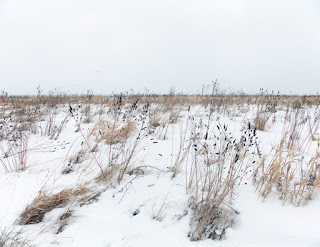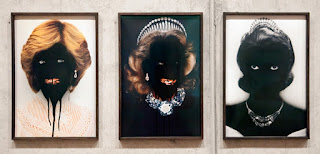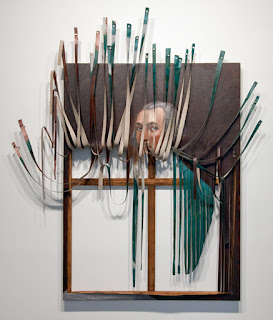This is the first I've done it, but I thought it would be fun to recap the year in
photographs. It seems especially fitting as it was a year of many firsts, as you will see. It was my good fortune that 2015 provided me with many
opportunities to make photographs both at home and abroad. My selections will be personal and subjective but some of them also represent significant stories. Art and nature both are well represented, along with combinations of art & nature. In an effort to highlight the photos I will keep the captions brief. When there is a story and/or additional photos I will provide a link.

While I often find it hard to pick favorites, I do have a few, maybe three, which I'll identify as they appear. I begin with one of them, the "Big Bang" over the Calatrava (July 3.) The story also was a major one, about the abuse of executive power and the fate of O'Donnell Park.
Most of the photos will come in rough chronological order. On New Year's Day, Jan. 1, 2015, I found myself ensconced at the Lynden Sculpture Garden as one of their artists in residence. That day and throughout the year I photographed the environment (ice on the pond, above) and the sculptures ("Salem 7," below) with an eye to congruence and contrast.
On January 2 it snowed. I have too many favorite images from the Lynden to include here. But I did create a gallery for them on my website.
As you may recall, after it snowed we had snow cover--and bitter cold--for months. A bleak winter, seen here at Lakeshore State Park. Photo essay.
A long-awaited milestone was reached in February when the MMSD began to remove the last stretch of concrete channed from the Menomonee River. Photo essay.
I also returned to Starved Rock State Park, IL in February. My fourth visit and the first time I saw an eagle up close. Photo essay.
February was a busy month! The Lynden Sculpture Garden held its Winter Carnival, which featured this inflatable and interactive sculpture by Claire Ashley. The story.
Trying to escape the seemingly endless winter, in March I went to New Orleans to attend the Society of Photographic Education national conference. When it wasn't raining, there was fog.
In April I spent a night near Horicon Marsh National Wildlife Refuge. Witnessed a controlled burn in progress and got another of my favorite images in a burned-over area. Photo essay.
Another long-anticipated change came when the Mandel Group began construction of their Echelon apartments on the County Grounds. They dwarf the four remaining historic Eschweiler buildings, two of which were being demolished as the year ended. One of several photo essays.
Earth Day saw the beleaguered Kinnickinnic get cleaned up. Although I'd been photographing all of Milwaukee's rivers off and on for years, this was the year that the KK became a major project for me. The cleaning of debris was the tip of the iceberg as MMSD ramped up its multi-year effort to remove concrete and restore a more natural river.
The highlight of the Earth Day event was when a water scientist from UW--Madison dyed the river red. The story.
Working with the MMSD one of my responsibilities was to document the deconstruction of houses that needed to be removed from the KK River floodplain. The most poignant thing I found in advance of the salvage and wrecking crew was this bedroom wall painting.
A makeshift memorial next to a railroad bridge crossing the KK provided an even more sobering image.
On a lighter note, while wandering the abandoned industrial Solvay property where the KK merges with Milwaukee's inner harbor I found this wedding party picking their way daintily among the ruins to find a backdrop for their group portrait. More KK River photos on Flickr.
In May the Lynden Sculpture Garden celebrated the 5th anniversary of being open to the public. Among other festivities, there was a display of bonsai trees. The story.
If there was a single highlight of my year at the Lynden it was the performance in June of the the Fairy Queen Fantasy, a combined effort of Danceworks and Milwaukee Opera Theater. Photo essay.
Peregrine falcons, and their protector, Greg Septon, were among my favorite subjects this year. I visited five nesting sites where Septon banded fledglings. This one is atop the Jones Island sewage treatment plant. The story.
I left town in June. On a hike at Devil's Lake State Park I came across these two young women attending to their cell phones high above the lake.
I also made my first visit to Portland, OR. I'd long wanted to visit the country's largest urban forest (above), which was both beautiful and well-appreciated by Portlandiers.
At the renowned and very popular Japanese Gardens I was struck by the similarities and contrasts between the formal gardens and the wilderness park. The trip to Portland inspired one of my most important essays of the year: "Could Milwaukee be a 'green' destination?"
 |
| image courtesy William Zuback |
Among multiple trips to Chicago, this ceramic installation at the National Museum of Mexican Art was especially compelling. Entitled Deportable Aliens, it is by Rodrigo Lara Zendejas. The story.
"Interval," by David Hartt, a massive multi-media installation at the Art Institute of Chicago, was also very moving.
While wandering the streets of Chicago I found this bus cleverly disguised as a forest. Art, nature, lifestyle, advertising--where do the lines blur or cross?
My own artistic moment of 2015 was the exhibit of work done during my 2014 year of residency in Milwaukee's Menomonee Valley, displayed at Walker's Point Center for the Arts. My image of Mayor Tom Barrett walking in Three Bridges Park may have been what drew the mayor himself to see the show.
Another first this year: I enjoyed one of the state's premier outsider art installations at Wisconsin Concrete Park. Up north in Phillips, WI, it features the work of Fred Smith.
The reason I was up north, actually, was for a bit of R&R. My wife (in the kayak) and I stayed in a cabin in Manitowish Waters, right on the Manitowish River.
While working on the essay, previously mentioned, about why Milwaukee could be a green destination, I spent a lot of time exploring Milwaukee's parks, some quite familiar (Lake Park, above) and a few for the first time. To see selections from my explorations, go to my Mke Parks Flickr album.
In addition to the parks, I was able to interview some of Milwaukee's human resources, including Will Allen, founder of Growing Power. The story.
Explosions of trains carrying crude oil caught the attention of a local advocacy group called Citizens Acting for Rail Safety. In September they staged a river rally to raise awareness that the same potentially lethal trains run through downtown Milwaukee. The story.
More travel in October. First, I revisited Ghost Ranch, my spiritual home in New Mexico, for the umpteenth time. But nothing is ever the same. This time I managed to catch a rainbow behind the always dramatic Battleship Mesa (above).
From NM I flew to Australia--yet another first. These two lorikeets in a wildlife sanctuary are just a taste of how exotic that proved to be. More photos (yes, kangaroos and koalas included) in my Flickr album.
From Australia to New Zealand. Of the several stories I wrote up about my adventures, my favorite is of volcanic Rangitoto Island, in the gulf off Auckland, NZ. The story.
Of course, art featured in my antipodean travels. I especially loved seeing the work of indigenous artists. I visited (and posted stories/photos) about museums in Adelaide, Melbourne and Auckland.
At the Hal Tyrrell Trailside Museum of Natural History in River Forest, IL, I snapped this portrait of a one-eyed red-tail cleverly named "Ethan Hawke."
This is a snapshot of Lisa Sutcliffe, curator of photography at Milwaukee Art Museum, taken at the Photo Council holiday party. That's cool in itself, but what's really important about this image? It was the very first photo I shot with...drumroll...my new iPhone.
Of course, after that I had to do my first selfie. I got my 4-year-old granddaughter to help me with that. Naturally, she upstaged me.
Next I jumped on the Instagram bandwagon. Fun! Of the many photos I uploaded to Instagram at the Lynden Sculpture Garden, mostly of the iconic, monumental sculptures, this one of the bench and puddle was most popular.
Speaking of popular, my photo essay of this stormy day on Lake Michigan went locally viral. See it for yourself.
Last but hardly least, another of my favorites. This one, appropriately, is from the Lynden Sculpture Garden. I loved being in residence there. Quite a privilege. Since it's not obvious, I must say that this is an unmanipulated, trick-free photo. One of those rare miracles of serendipity that make photography marvelous. The blue out-of-focus foreground is part of a sculpture, "Quartet," by Forrest Myers. Art and nature. (Lynden Sculpture Garden Flickr album.)
Have a wonder-full New Year!































































